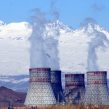
Armenia Passes International Nuclear Safety Test
Publication: Eurasia Daily Monitor Volume: 8 Issue: 142
By:

A team of international inspectors acting under the aegis of the International Atomic Energy Agency (IAEA) has given a largely positive assessment of the operational safety of Armenia’s Metsamor nuclear power plant. Its recently publicized preliminary findings are putting the Armenian government in a better position to ignore renewed calls for the closure of the Soviet-era plant and maintain the country’s heavy reliance on nuclear energy in the long term.
The government decided to ask the IAEA to examine safety practices at Metsamor in mid-March, following the nuclear disaster in Japan, which rekindled local environmentalists’ concerns about the facility. Like Japan, Armenia is located in a seismically active zone prone to the kind of powerful earthquakes that triggered the series of explosions at the Fukushima nuclear plant. Armenian environment protection groups said this alone should compel the country not to have any nuclear facilities on its territory. Government officials and nuclear experts in Yerevan dismissed these concerns (see EDM, April 11).
The IAEA-led Operational Safety Review Team (OSART), which comprised 11 experts from the United States, Britain, France and five other countries, arrived in Armenia in mid-May. It spent the following two weeks inspecting Metsamor’s reactor and other facilities, evaluating the plant’s safety and maintenance procedures, and interviewing its personnel.
“The results of our inspection show that this [environmental] risk is acceptable,” Gabor Vamos, the Hungarian head of the OSART, told a news conference in Yerevan. He said the inspectors submitted their preliminary findings to the Armenian authorities and will release a final report within three months (www.armenialiberty.org, June 2).
The OSART mission found at Metsamor seven “good plant practices” that will be recommended to the nuclear industries of other nations for consideration. According to a separate IAEA statement issued on June 2, one of those examples is the fact that in recent years “several important safety systems have been updated using the resources of the plant’s staff.” “This unique approach resulted in staff acquiring deep knowledge and skills to successfully operate and maintain new equipment,” read the statement.
The statement also stated: “The plant has developed a specific, comprehensive system supported by procedure to mitigate the consequences of a station blackout by providing power to systems and components necessary for cooling the reactor in emergency conditions.” This conclusion must have been particularly heartening for the authorities in Yerevan given the fact that the Japan disaster was caused by the failure of Fukushima’s reactor cooling system. The system in place at Metsamor is markedly different and, according to Armenian officials, more reliable than Fukushima’s.
The OSART also reported a number of shortcomings in Metsamor’s operations and made relevant recommendations on how to address them. In particular, Vamos noted that Metsamor technicians do not quickly identify all equipment deficiencies that require urgent repairs. The Armenian authorities should work out a more rigorous mechanism for keeping the plant’s equipment in an “ideal state,” he said.
Armenian President Serzh Sargsyan seized upon the IAEA-led mission’s assessment to declare that the plant generating about 40 percent of Armenia’s electricity does not pose a significant safety risk to the environment. Speaking at the Council of Europe’s Parliamentary Assembly (PACE) later in June, Sargsyan said that despite this “fairly good evaluation,” the Armenian authorities will carry out more safety upgrades there. He also insisted that his landlocked country has no choice but to continue to rely on atomic energy because of the long-running economic embargoes by neighboring Azerbaijan and Turkey (Armenian Public Television, June 22).
One key element of this energy security strategy is an ambitious project to replace Metsamor’s sole functioning reactor (built in 1980, brought to a halt in 1989 and reactivated in 1995) with a new and much more powerful one. The Armenian government planned to organize a conference for potential foreign investors in Yerevan in late April as part of its ongoing efforts to attract an estimated $5 billion in funding needed for the project’s implementation.
Armenian Minister of Energy and Natural Resources, Armen Movsisian, said last week that the conference will take place this fall. He attributed the postponement to the Fukushima disaster and its negative implications for the global nuclear industry. In Movsisian’s words, Russia’s Rosatom state nuclear energy agency and “a couple of companies from other countries” have already expressed an interest in participating in the new plant’s construction. However, the minister did not name them (www.tert.am, June 13).
Armenian officials have said in the past that the construction will start by 2012 and probably end in 2017, in time for Metsamor’s planned decommissioning. However, these time frames look increasingly unrealistic, suggesting that the existing plant will operate several years longer than planned. The OSART’s conclusions will only make it easier for Yerevan to dismiss domestic and international criticism of this delay.
Vamos told journalists in the Armenian capital that Metsamor’s VVER-440 light-water reactor can safely operate beyond its design life span. “In principle, there is such technical possibility,” said the IAEA mission head.




